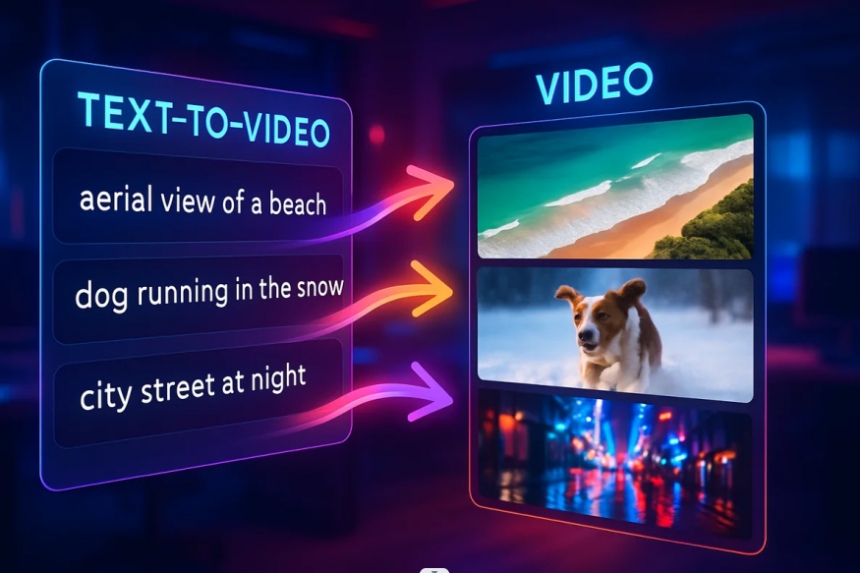In the ever-evolving landscape of digital content, the quest to create high-quality visuals using minimal resources is gaining importance. The new technologies of Text to Video and Video to Video AI are changing the production, editing, and delivery of visual content. Looking into the future, these tools could be of game-changing relevance and could be beneficial to a wider range of individuals, including educators crafting course content, students preparing for thesis presentations, and content creators on social media platforms.
1. The Power of Text to Video AI for Effortless Visual Narratives
Text-to-Video AI is a developing technology, a recent addition to automated media production technologies. All that is needed to create a dynamic video is a written prompt, and the video creation tools are able to work wonders. The technology used interprets the prompt, extracts contextually appropriate visuals, and weaves them into scenes coherently. This is remarkably helpful in the spheres of education, journalism, and online training, which require the production of visuals but have infotainment budgets.
Working on e-learning modules for a nonprofit, I was able to utilize AI video platforms to create engaging animated videos from complex scripts.
The results achieved not only saved hours of time in production work but also increased engagement by 40% relative to slide presentations. In addition to simple text entries, the AI integrated contextual music, transitions, and even voice overs.
2. Redefining Footage Quality with Video-to-Video AI Enhancements
Unlike Video to Text, which focuses on creating a video text from scratch, Video to Video AI specialists in the improvement and modification of existing footage. These tools use sophisticated neural networks and style transfer techniques to enhance video resolution, colour, and lighting. They also add artistic effects and even change backgrounds—all automatically.
For digital editors and video marketers, it means fewer expensive software suites and shorter rendering times. Personally, I have used Video to Video AI to upscale low-resolution social media content and interview recordings, transforming them into crisp, professional-grade footage. Achieving what used to take multiple plugins in a traditional editor is a single AI model is nothing short of stupendous when it comes to saving time and boosting quality.
3. Bridging Creativity with Efficiency: Why You Should Use Both
The integration of Text to Video and Video to Video AI offers a smart and efficient production workflow. The process can begin with a video overview created from text and subsequently edited to enhance style and quality using video-to-video AI. This style refinement adds a two-tiered layer to the two-step procedure and addresses the issue of a creative logjam. It further opens up next-level tweaks to be made regardless of the user’s level of expertise.
Students working on capstone projects and teachers creating content from remote classes stand to gain the most from this combination. A few weeks back, a colleague of mine created a draft video for a science explained on renewable energy using a text-to-video tool. After generating the base video, he enhanced it by adding branded visuals, smoother transitions, and voice sync using a video-to-video AI model with no heavy lifting.
4. Real-World Applications in Academia, Business, and Media
Text-to-Video and Video-to-Video AI can be utilized by creators beyond YouTube and TikTok. In academic research, these tools are now helping scholars turn papers into engaging video summaries. Universities are adopting them to make online courses more immersive. Meanwhile, in the business sector, brands are using AI-generated videos to quickly produce product explained, internal training material, and event promos.
Media experts are now looking into how video-to-video models can be leveraged for dubbing multimedia assets into various languages, applying cultural adaptation visually, or even creating B-roll from scripts. The sophistication of AI technology is evolving alongside emerging new applications.
5. What’s New in 2025: Advanced Features in AI Video Creation
The incorporation of multi-modal inputs in Text-to-Video and Video-to-Video AI is spearheading advancements this year. Users can now integrate voice memos, sketches, and reference images alongside written text to direct the output with greater precision. Furthermore, temporal consistency engines that preserve the smoothness of transitions and character consistency across multiple frames or scenes are now offered by some platforms.
Content creators can now tell the story more effectively, devoid of visual inconsistencies that used to be troublesome. For academic users, animators no longer have to be relied upon to depict timelines, historical events, or scientific processes.
Final Thoughts:
The emergence of AI in smart video creation marks the beginning of the new normal when it comes to the novel functionalities of Tools powered by AI to record and render videos through Text to Video and Video to Video AI require fewer resources and time, especially for the creators of visual stories through video films and shorts. The emerging technologies of Text to Video AI and Video to Video AI are a breakthrough in the smart automation for the creators in the industry. The emerging technologies of AI are geared towards assisting in job automation, enabling creators to move from concept to a final product in a matter of hours instead of weeks.






